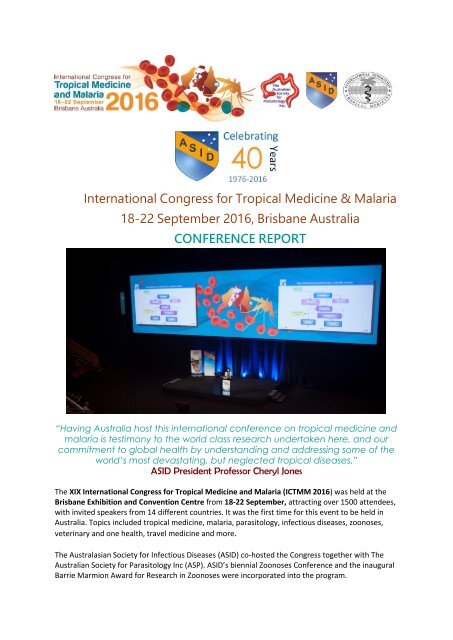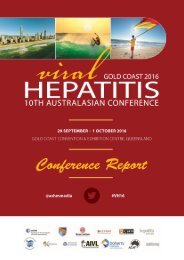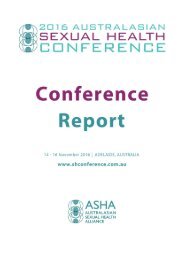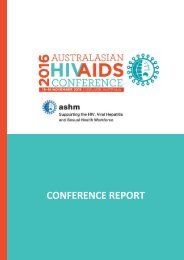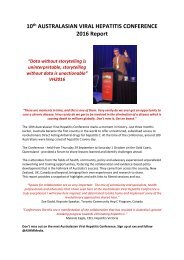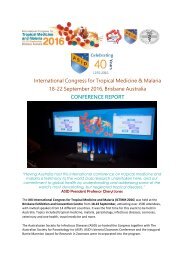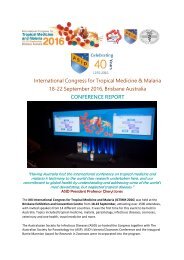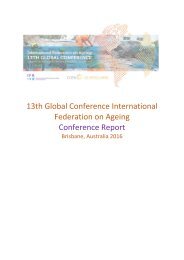ICTMM16_Congress_Report
Create successful ePaper yourself
Turn your PDF publications into a flip-book with our unique Google optimized e-Paper software.
International <strong>Congress</strong> for Tropical Medicine & Malaria<br />
18-22 September 2016, Brisbane Australia<br />
CONFERENCE REPORT<br />
“Having Australia host this international conference on tropical medicine and<br />
malaria is testimony to the world class research undertaken here, and our<br />
commitment to global health by understanding and addressing some of the<br />
world’s most devastating, but neglected tropical diseases.”<br />
ASID President Professor Cheryl Jones<br />
The XIX International <strong>Congress</strong> for Tropical Medicine and Malaria (ICTMM 2016) was held at the<br />
Brisbane Exhibition and Convention Centre from 18-22 September, attracting over 1500 attendees,<br />
with invited speakers from 14 different countries. It was the first time for this event to be held in<br />
Australia. Topics included tropical medicine, malaria, parasitology, infectious diseases, zoonoses,<br />
veterinary and one health, travel medicine and more.<br />
The Australasian Society for Infectious Diseases (ASID) co-hosted the <strong>Congress</strong> together with The<br />
Australian Society for Parasitology Inc (ASP). ASID’s biennial Zoonoses Conference and the inaugural<br />
Barrie Marmion Award for Research in Zoonoses were incorporated into the program.
TROPICAL MEDICINE HIGHLIGHTS: Malaria<br />
The <strong>Congress</strong> opened with Professor John Reeder,<br />
WHO, on the evolution of The Special Programme<br />
for Research and Training in Tropical Diseases<br />
(TDR), a global programme of scientific<br />
collaboration that helps facilitate, support and<br />
influence efforts to combat diseases of poverty.<br />
He was followed by Dr BT Slingsby, CEO of Global<br />
Health Innovative Technology Fund (GHIT), a<br />
public-private partnership that leverages Japanese<br />
innovation and leadership to advance R&D for<br />
novel health technologies for the developing world. Innovative public-private partnerships to<br />
stimulate R&D were a major theme of the <strong>Congress</strong>.<br />
Read about GHIT’s new funding for a single dose antimalarial and vaccines for dengue + TB.<br />
AUSTRALIAN MALARIA RESEARCH<br />
From Australia, ASID’s Professor James McCarthy, QIMR, presented on the use of experimental<br />
human malaria infection to improve the understanding of the pathogenesis of malaria and to<br />
develop new diagnostics, drugs and vaccines. He was interviewed by Dr Norman Swan from ABC’s<br />
Health <strong>Report</strong> in the lead up to the conference.<br />
Listen to the Health <strong>Report</strong> interview or read the transcript<br />
Read the study published in the MJA that suggests breath biomarkers could be exploited in a<br />
simple, malaria breath diagnostic.<br />
Read the study on induced blood-stage Plasmodium vivax infection in healthy volunteers.<br />
MALARIA VACCINE WITHIN REACH<br />
Dr Stephen Hoffman: Sanaria’s PfSPZ malaria vaccine has yielded ‘unprecedented protection in<br />
clinical trials and is found to be safe, easily administered and protects for at least a year’. The vaccine<br />
received FDA fast track designation during the conference. By March next year Sanaria hope to have<br />
completed phase 2 trials to establish dosage regimen with a view to launching the vaccine in March<br />
2019. Strategy involves pursuing 2 parallel tracks to licensure: a vaccine for use in endemic regions<br />
and a vaccine for travellers, military and expat workers. Hoffman’s presentation focused on how to<br />
overcome the challenges faced in using this for elimination campaigns.<br />
Read Sanaria’s media release on vaccine efficacy<br />
Read the study published in Nature<br />
Read Sanaria’s media release on FDA fast track designation<br />
COLLABORATION PAVES THE WAY<br />
Associate Professor Matthew Todd: A unique “open source” study has created a collaborative<br />
patent-free environment that will accelerate the development of new malaria treatments, according<br />
to lead researchers at the Univ. of Sydney. Read the media release or the research article in ACS<br />
Dr Jorg Mohrle: A new potent antimalarial development candidate with potential for both treatment<br />
and prevention of malaria has been identified by a collaboration between Medicines for Malaria<br />
Venture (MMV) and an international network of partners. Read the media release.
TROPICAL MEDICINE HIGHLIGHTS: TB, HIV, Zika<br />
Snapshot: TB Priorities for Australia<br />
The soon-to-launched National Strategic Plan will inform<br />
those involved in TB care but also other Commonwealth<br />
and State and Territory Departments in areas where a<br />
'Health in All Policies' approach is needed. The plan aligns<br />
with WHO guidance on how to approach the elimination of<br />
TB from the global health landscape.<br />
For Australia this will mean targeting populations within our community that have higher rates of TB<br />
and higher risk of developing TB. Many of these persons may not have yet arrived in Australia as<br />
nearly 90 per cent of Australia's active TB cases were born overseas, usually in a country with high<br />
TB incidence. TB usually takes months/years to develop after initial infection but can take decades.<br />
Snapshot: HIV<br />
Professor Sharon Lewin updated the audience on the search<br />
for an HIV cure. The world simply can’t afford to put<br />
everyone with HIV on lifelong treatment, she said, and a<br />
cure will be essential.<br />
Today, achieving long-term remission of the virus is<br />
considered a “functional cure” for HIV. However,<br />
measurement of such remission needs to be standardized<br />
across the industry to allow for better comparison of<br />
research on this topic. Other cure studies presented include<br />
“shock and kill” in various European countries, whereby the<br />
virus is activated and then treated with a vaccine; and a<br />
clinical trial of adults who initiated treatment early and then<br />
stopped medications while being closely monitored. HIV<br />
cure research can benefit from advances in cancer research,<br />
as well, Lewin concluded.<br />
Watch a video interview with Sharon Lewin<br />
Snapshot: Zika Virus<br />
Zika Virus continued to peak interest, with Dr Federico Costa providing an update from Brazil. Their<br />
current perspective is that ZIKV causes a congenital infection and syndrome distinct from other<br />
causes of microcephaly. However, he raised caveats in attributing the entire burden of microcephaly<br />
to congenital Zika syndrome. An effective response to this emergency will require systematic<br />
investigation of pregnant women and newborns, a serologic test that detects exposure in utero and<br />
stratifies risk among women of child bearing age, and a fundamental understanding of all modes of<br />
ZIKV transmission in order to project future trends and risks.<br />
Travel Medicine: A message for GPs<br />
Given the boom in travel, tropical medicine should not be considered an exotic field for GPs, writes<br />
ICTMM Presenter Dr Colleen Lau.<br />
Read her article in Medical Observer and the media release issued by ASID.
BURDEN OF DISEASE: Aboriginal Populations<br />
Snapshot: Global burden of<br />
neglected diseases<br />
PLOS Neglected Tropical Diseases co-Editor-in-<br />
Chief Dr Peter Hotez’ presentations brought into<br />
sharp focus the changing health landscape, with<br />
widespread poverty-related neglected diseases<br />
occurring predominantly among the poor living in<br />
wealthy G20 countries. Such findings represent a<br />
significant departure for the way in which we usually think about global health and as a result have<br />
important policy implications for the G20 leaders and governments. This concept - “Blue Marble<br />
Health” - was first expressed in 2011 and is now in a new book with 38 new research papers.<br />
Investigators are invited to continue contributing new papers to this collection. Read more in PLOS.<br />
Indigenous Australia<br />
Dr Peter Hotez also focused on diseases of poverty in global Aboriginal populations, who account for<br />
15 per cent of global poverty even though they comprise only 5 per cent of the global population.<br />
In Australia, the greatest burden of neglected tropical diseases is in Indigenous populations in<br />
remote and rural areas of the Northern Territory:<br />
Strongyloidiasis: hyperendemic and often associated with (HTLV-1) co-infection<br />
Hookworm: caused by Ancylostoma duodenale<br />
Intestinal protozoan infections<br />
Ectoparasitic scabies<br />
Secondary group A streptococcal (GAS) infections & impetigo (extremely common)<br />
Post-streptococcal sequelae: including glomerulonephritis and rheumatic heart disease. (In<br />
some cases secondary staphylococcal infections occur.)<br />
Trachoma: still common in remote rural areas, although recently the Australian government<br />
committed to eliminating this disease.<br />
Melioidosis (Burholderia pseudomallei' infection): also common during the wet season.<br />
ASID Focus: Rheumatic Fever<br />
ASID issued a media release from the <strong>Congress</strong> on Rheumatic Fever:<br />
“Rheumatic Fever is a disease of poverty and neglect, normally associated with developing<br />
countries. However, the highest rates of Rheumatic Fever in the world are actually found here, in<br />
Australia’s Indigenous children.”<br />
Professor Bart Currie, Director of RHD Australia and ASID Secretary.<br />
The Australian guideline for prevention, diagnosis and management of acute rheumatic fever and<br />
rheumatic heart disease provides a clear opportunity to turn this around by identifying standards of<br />
care, introducing evidence based management strategies and ensuring high-risk populations receive<br />
the same standard of care as that available to other Australians. Read ASID’s media release.
TROPICAL MEDICINE HIGHLIGHTS: Paediatrics and Mycology<br />
ASID Focus: PAM<br />
Research presented at the <strong>Congress</strong> and then published in the Medical Journal of Australia (MJA)<br />
drew attention to a very rare but fatal brain infection mostly affecting children. Primary Amoebic<br />
Meningoencephalitis (PAM) is caused by amoeba such as Naegleria fowleri and is typically found in<br />
warm fresh water, such as ponds, lakes, rivers, hot springs and poorly maintained municipal water<br />
supplies. Rural and remote communities are particularly at risk, where hot bore water and long<br />
surface pipelines promote the growth of large concentrations of the disease-causing amoeba. ASID<br />
President Professor Cheryl Jones warned health professionals and communities to be on alert to<br />
PAM with summer approaching, and respond immediately to any suspected infections by alerting<br />
their laboratories to look for amoebae.<br />
Read the ASID media release on PAM<br />
Read the study in MJA<br />
Related coverage: MJA Insight; Medical Observer; SMH;<br />
TROPICAL MEDICINE HIGHLIGHTS: Mycology<br />
The ASID-run Tropical Mycology session at the ICTMM included presentations by Ed Zulstra, Wieland<br />
Meyer and Isabella Gremiao.<br />
Fungal Diagnostics in Resource Poor Settings<br />
Wieland Meyer and Debbie Marriott<br />
The global burden of fungal disease is difficult to assess but likely to be significantly underestimated<br />
due to inadequate surveillance, lack of recognition of fungal infection and poor<br />
diagnostic tests.<br />
However, it is likely that fungal infections add a substantial burden to health care making rapid,<br />
accurate and affordable diagnosis essential.<br />
Diagnostic modalities include direct microscopy, histopathology, culture, antigen testing,<br />
molecular techniques.<br />
This presentation discussed the pros and cons of each.<br />
Read a news article in the Lancet: “Bringing fungal infections in from the cold”<br />
IN THE NEWS<br />
Data from Labceutics’ Infectious Disease Lap Mapping Program<br />
Marketwired<br />
Laboratory Testing Data From More Than 19 Tropical and Developing Countries Provides Unique<br />
Insight Into Potential for Outbreak and Resistance Tracking Using Molecular Diagnostics.<br />
Rat lungworm study sheds light on disease<br />
Hawaii Tribune Herald<br />
East Hawaii Island is the epicenter for rat lungworm infections, said ... part of the International<br />
<strong>Congress</strong> for Tropical Medicine and Malaria.
SNAPSHOT: PUBLIC HEALTH IN THE PACIFIC<br />
ASID Focus: Antimicrobial Resistance<br />
Nicola Townell<br />
Pacific Island countries are developing and implementing national AMS programs.<br />
They face significant challenges: lab detection of resistant organisms + surveillance, lack of<br />
antimicrobial guidelines, poor awareness and understanding of AMR and infection control<br />
practices, lack of local leadership and external support.<br />
Discussion of case study: Solomon Islands<br />
Success of SI program dependent on multi-disciplinary educational approach w local HCW taking<br />
ownership whilst collaborating with international supporting partners.<br />
Labs’ ability to perform susceptibility testing and clinicians’ level of knowledge and understanding<br />
in respect to diagnosis, management and prevention of infection requires further attention.<br />
Read the WHO report on tackling AMR in the Solomon Islands<br />
ASID Focus: Newly Recognised Cause of Chronic Skin Ulceration<br />
Sally Roberts<br />
Haemophilus ducreyi is the causative agent of chancroid, a genital ulcer disease common in<br />
developing countries.<br />
There is increasing evidence to support its previously unrecognised role as a causative agent of<br />
chronic skin ulceration in children in South Pacific Island Countries and Territories (PICT).<br />
2 recent studies in PNG and SI have demonstrated high rates of H. ducreyi in skin lesions.<br />
Additional work is needed to better understand the role of H. ducreyi in chronic skin ulceration.<br />
Read a study by Sally Roberts in PLOS Neglected Tropical Diseases<br />
Role of Tropical Islands in Globalising of Emerging Arboviruses<br />
Van-Mai Cao Lormeau<br />
Zika virus (ZIKV) appeared for the first time in the Pacific in 2007, expanded regionally and, in 2015,<br />
emerged in Brazil. This study found that remote islands, with small populations mostly<br />
immunologically naïve for new emerging arboviruses, combined with an environment highly suitable<br />
for mosquito-borne diseases, should be considered as ideal hubs for virgin soil outbreaks of such<br />
viruses, and subsequent geographic expansion through international travel. In addition, if remote<br />
tropical islands experience outbreaks before more populated continental countries, such areas could<br />
serve as sentinel sites.<br />
Cervical Cancer Prevention in Emerging Nations<br />
Ian Frazer<br />
The HPV vaccine has been successfully delivered to preteen girls in Bhutan and Vanuatu, but<br />
sustaining the programs has proven challenging despite donated vaccine, and government and<br />
community support. Different modes of cervical screening have been trialled in Vanuatu, and the<br />
best combination of sensitivity and specificity was obtained with HPV testing amongst over 30 year<br />
olds. The CareHPV test has been successfully delivered under tropical conditions, but central<br />
laboratory facilities are necessary for reagent storage. Provision of QA and QC, and assuring<br />
compliance with follow up from positive screening tests remains a challenge.<br />
Read about in Ian Frazer in Vanuatu
BARRIE MARMION ZOONOSES AWARD<br />
“The Barrie Marmion Zoonoses Award gives us the opportunity to further shine the spotlight on our<br />
achievements, by highlighting the best zoonoses-related research being presented here. We are<br />
thrilled to offer this award to Dr Stephen Graves, for his invaluable contribution to Q Fever research.”<br />
Professor Cheryl Jones, ASID President<br />
ASID’s Barrie Marmion Zoonoses Award was presented at the <strong>Congress</strong> to Professor Stephen Graves,<br />
Director of the Australian Rickettsial Reference Laboratory, for his work on Q Fever.<br />
Read ASID’s media release about the Barrie Marmion Zoonoses Award and find out how<br />
you can apply for 2017.<br />
Q Fever Fatigue Syndrome<br />
Professor Graves provided an update on Q Fever Fatigue Syndrome, emphasising the challenges of<br />
diagnosis and likelihood of misdiagnosis. He recommended vaccinating all Australian teenagers in<br />
rural areas in their last year of school. “Q Fever is a preventable disease that can have disastrous<br />
consequences,” he said.<br />
View Professor Graves slides on what you need to know about Q Fever.<br />
Read ‘The natural history of acute Q fever: a prospective Australian cohort’<br />
Q Fever in Children<br />
Associate Professor Clare Nourse presented on chronic recurrent multifocal Q fever osteomyelitis<br />
in children. This rare manifestation of chronic Q fever infection is poorly understood, and effective<br />
treatment options have not been established, leading the presenter to refer to it as ‘one of the most<br />
significant clinical conundrums of today’.<br />
Read new research by Clare Nourse and others is The Paediatric Infectious Disease Journal.<br />
Q Fever in Companion Animals<br />
Dr Amada Shapiro from UNSW presented on Q<br />
Fever in companion animals in Australia,<br />
reinforcing the need for vaccination in cat<br />
breeders, highlighting low awareness and<br />
touching on potential novel sources of infection<br />
requiring further study.<br />
Read ASID’s media release.<br />
Read the article in Medical Observer
ICTMM 2016 IN PICTURES<br />
Left: Over 1500 people attended<br />
ICTMM 2016 from all around the<br />
world.<br />
Right: Conference Convenor<br />
Professor David Looke gives his<br />
opening address.<br />
Below: The social program<br />
provided multiple networking<br />
opportunities, including a<br />
fantastic <strong>Congress</strong> dinner at the<br />
beautiful Lone Pine Koala<br />
Sanctuary, which was fully<br />
booked. Attendees enjoyed a<br />
traditional Australian BBQ in<br />
the world’s first and largest<br />
koala sanctuary.<br />
Above: Malcolm Jones,<br />
Convenor for the Australian<br />
Society of Parasitology, receives<br />
Honorary Life Membership of<br />
ASID for his work in bringing the<br />
<strong>Congress</strong> to Australia and<br />
involving ASID as co-hosting<br />
Society.<br />
Below:<br />
The packed Exhibition Hall had<br />
over 18 booths and provided<br />
excellent opportunities to<br />
network in a favourable<br />
environment that provided a<br />
meeting place for all<br />
participants.<br />
.<br />
Right: an Early Career<br />
Researchers Breakfast, hosted<br />
by ASP and ASID for over 160<br />
attendees, was very well<br />
received and might be<br />
replicated at other ASID<br />
meetings and conferences.<br />
Other events associated with<br />
the <strong>Congress</strong> were 8<br />
workshops, which ran<br />
throughout the <strong>Congress</strong>, and a<br />
Technical Tour of a Phase I<br />
Clinical Trial facility. The<br />
<strong>Congress</strong> was highly successful<br />
and has significantly increased<br />
ASID’s international profile.
We would like to say a special thank you to our <strong>Congress</strong> Sponsors<br />
and Program Supporters.


